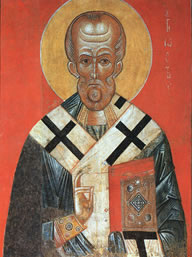 |
St
Nicholas Russian icon 13th or 14th century |
Christmas—for most Western Christians and members of the Greek Orthodox Church—is traditionally considered to begin on the evening of 24 December. Historically, days started at sunset, so the evening of the day came first. When the reckoning of time changed so that a day started at midnight, the “eve” of any particular day became the evening of the previous day.
On Christmas eve, carol services and midnight masses herald the celebration of the birth of Jesus. Other traditions are clearly linked to earlier pagan rituals and include decorating the Christmas tree and preparing for the arrival of Santa Claus.
Early Christmas music compositions were typically chants and hymns. ‘Carol’ originally referred to a circle dance which did not have any singing. As the church struggled against the influences of pagan customs, these carols was barred from sacred services. However, outside the church, simple folk songs recounting the story of the nativity were written and became hugely popular.
Saint Francis of Assisi is credited with bringing songs that were more akin to what we know as carols into the formal worship of the church during a Christmas midnight mass in Umbria in 1223 CE. Carols enjoyed further development and popularity when they were used in the mystery plays of the Middle Ages.
In
some areas of Scandinavia and Germany people placed evergreen trees inside
their homes or just outside their doors in winter to show their hope in
the forthcoming spring, and the modern Christmas tree has evolved from
these early traditions.
The greatest influence contributing to the shaping
of the familiar gift-giving Santa Claus was a fourth century bishop, Saint
Nicholas of Myra (now Turkey). As a champion of children and the needy,
he was legendary for his kindness and generosity.
The date of his death, 6 December, was commemorated with an annual feast,
which gradually came to mark the beginning of the medieval Christmas season.
On St Nicholas’ Eve, youngsters would set out food for the saint,
straw for his horses and schnapps for his attendant. The next morning,
children awoke to find their gifts replaced with sweets and toys.
After
the Protestant Reformation in the sixteenth century, the feasting and
veneration of Catholic saints was banned. But people had become accustomed
to the annual visit from their gift-giving saint, so in some countries,
the festivities of St Nicholas’ Day were merged with Christmas celebrations.
Although the gift-bearer took on new, non-religious forms, he still reflects
the saint’s generous spirit; the name Santa Claus evolved from Sinter
Klaas, a shortened version of the Dutch Sint Nikolaas.